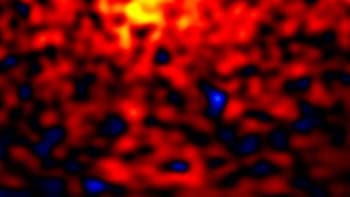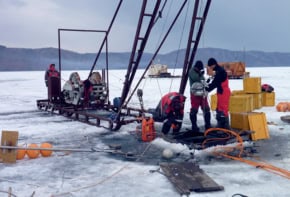
Physicists remain sceptical about claims made last week that dark matter has been detected at a laboratory in Italy, insisting that the data need to be backed up by further experiments. The Italian team, which made the claims at a meeting in Venice, says it has strong evidence that dark matter takes the form of weakly interacting particles.
Dark matter was originally put forward to explain why galaxies appear to contain just a fraction of the mass they need to rotate at their observed speeds. Nobody has yet managed to see it directly, although astrophysical measurements imply that it should make up around 95% of the total matter in the universe, mostly in “haloes” around the centre of galaxies.
No-one disputes that the DAMA team observes an annual modulation, but the community needs to be persuaded that dark matter has anything to do with it Henrique Araujo, ZEPLIN-III experiment
In 2000 physicists working at the DAMA experiment at the Gran Sasso laboratory in Italy said they had discovered what many believe is the most promising candidate for dark matter: a weakly interacting massive particle, or “WIMP”. Such a particle would not interact with light, although it would interact with normal matter through the weak nuclear force. In fact, it might interact enough to occasionally collide with a nucleus inside some 100 kg of sodium-iodide, which the DAMA team kept in an array of detectors buried more than a kilometre underground.
The DAMA team found that flashes of light produced by recoiling nuclei inside their detectors tended to be more frequent in July than in December. This seasonal modulation fitted with the prediction that the Earth should switch its movement to be with or against the prevailing “wind” of WIMPs as it orbits the Sun, which is itself moving through our galaxy’s dark-matter halo. After analysing their results, they claimed this modulation pointed to a WIMP in the mass range 44 to 62 GeV — at the lighter end of the scale of those predicted by theory — and at a confidence level of 6.3 σ (or 99.9999998% certainty).
At the time many physicists suspected that the seasonal modulation could be the result of something more mundane, such as a change in ambient temperature. So, over the past eight years, the team have upgraded the amount of sodium iodide in their detector array to 250 kg. Last week they claimed that this upgrade, branded as “DAMA/LIBRA”, has enabled them to confirm the existence of the WIMP with an improved confidence of 8.2 σ.
Even with this level of certainty in the modulation, however, many remain unconvinced. “The DAMA announcement has had a mixed reception,” says Henrique Araujo of ZEPLIN-III, another WIMP experiment. “No-one disputes that they observe an annual modulation, but the community needs to be persuaded that dark matter has anything to do with it.”
Agrees with predictions
The DAMA team insist that their signature matches the dark-matter signature that was predicted in the mid 1980s by theorist Katherine Freese. Rita Bernabei, a spokesperson for the DAMA team, says: “The former DAMA experiment over seven annual cycles and the new DAMA/LIBRA experiment over four annual cycles show, with high confidence level, agreement with all the features expected for the presence of dark-matter particles in the galactic halo.”
Other physicists point out other potential causes for the modulation. Any neutral particle can scatter off a nucleus to make it recoil, so it is possible that the modulation signature is caused by neutrons from cosmic rays. However, several independent experiments have failed to find the same rate of bombardments by cosmic-ray neutrons in the DAMA experiment’s energy range (2–6 keV), which goes against this interpretation.
Another possibility is that the DAMA team are actually observing flashes of light produced by particles scattering off atomic electrons, rather than nuclei. “ZEPLIN-III might be able to detect an electron-recoil modulation at the rates and energies reported by DAMA, but for that we need a longer run,” says Araujo.
A third possibility is that the recoils are being produced by a hypothetical particle known as an axion. These light particles, which were conjured to resolve the “strong-CP” problem in the theory of the strong force in the late 1970s, have been suggested as candidates for dark matter before, but have so far evaded all attempts to be found. An axion fit to explain the modulation in the DAMA experiment would need a mass around 3 keV.
The DAMA experiments show agreement with all the features expected for the presence of dark-matter particles in the galactic halo Rita Bernabei, DAMA experiment
New physics?
Even if none of these alternative interactions is producing the seasonal modulation seen at the DAMA experiment, there is still a question as to why other direct WIMP searches — such as ZEPLIN-III in the UK, CDMS-II and COUPP in the US, and XENON10 in Italy — have not recorded similar results. In the DAMA experiment’s energy range, these experiments have found no evidence for coherent scattering of nuclei, which is the WIMP-scattering process favoured by theory. “For the DAMA/LIBRA result be a true dark-matter signal requires a new interaction process, or other new physics,” says Alexander Murphy, also at the ZEPLIN-III experiment. “This would be extraordinary! The particle-physics theorists have predicted many scenarios, but not this.”
“If someone has detected dark matter, it’s clearly a Nobel-prize-winning experiment,” says Richard Gaitskell, who works on several direct WIMP searches. Gaitskell also notes that other interactions could be producing the signature seen at DAMA, but feels that the DAMA team has not yet been rigorous enough in calibrating their detector system. “What would be best would be if they could switch off their beam, like you can in a particle detector,” he explains. If such a thing were possible they would be able to see if the seasonal modulation is caused by anything else. “Unfortunately, you can’t switch off WIMPs,” he adds.
Bernabei told physicsworld.com that she and the rest of the DAMA team are confident they have performed all the necessary calibrations. But Gaitskell says it would have been better if the DAMA team performed a running calibration while they were taking experimental data by creating their own light flashes and looking for signs of seasonal modulation. “If I could have one thing for Christmas it would be to see clear calibration data showing the necessary stability,” he says.
• Preprints including the DAMA/LIBRA results can be found at arXiv:0804.2738 and arXiv:0804.2741.




